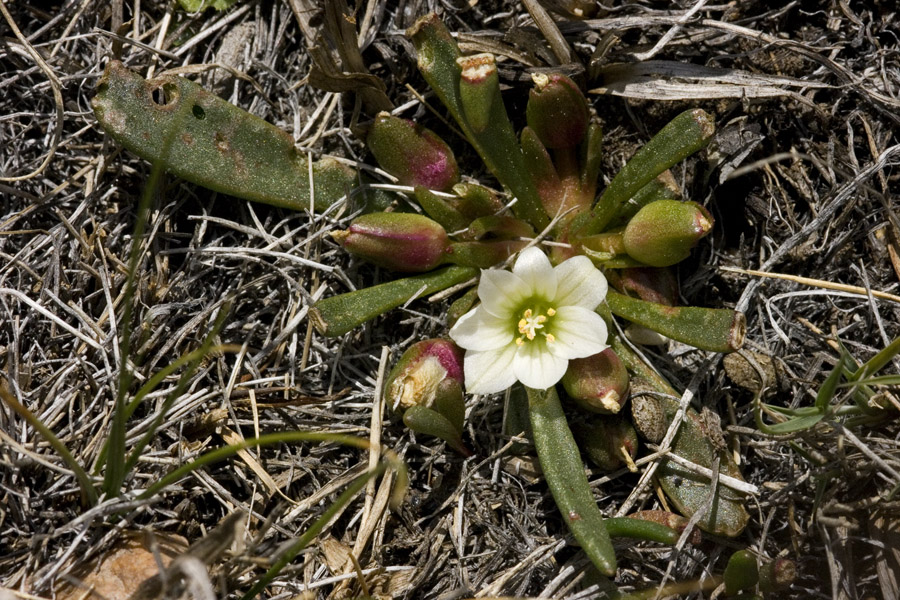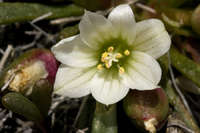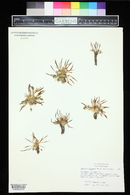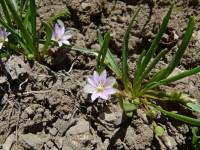|
|
|
|
Family: Montiaceae
alpine lewisia
[Lewisia minima (A. Nelson) A. Nelson, moreLewisia pygmaea var. aridorum Bartlett, Lewisia sierrae Ferris, Oreobroma pygmaeum (A. Gray) Howell, Talinum pygmaeum A. Gray] |
Taproots gradually ramified distally or shortly fusiform, rarely subnapiform. Stems ± prostrate or suberect, becoming reflexed in fruit, 1-6 cm. Leaves: basal leaves withering at or soon after anthesis, ± sessile or gradually tapered to long petiole, blade linear to linear-oblanceolate, ± flattened, 3-9 cm, margins entire, apex acute to obtuse; cauline leaves absent. Inflorescences 2-4(-7)-flowered in racemose cymes or with flowers borne singly; bracts 2, opposite, plus 1 subtending each successive flower if more than 1 flower, linear-oblong, linear-lanceolate, or lanceolate, (2-)4-10 mm, margins glandular-toothed, sometimes eglandular-toothed, apex acute. Flowers pedicellate, not disarticulate in fruit, 1.5-2 cm diam.; sepals 2, suborbiculate, broadly ovate, or obovate, 2-6 mm, herbaceous at anthesis, margins usually glandular-toothed, sometimes eglandular-toothed or rarely ± entire, apex usually truncate, sometimes rounded, obtuse, subacute, or apiculate; petals 5-9, white, pink, or magenta, sometimes green at base, narrowly oblong, elliptic, or oblanceolate, 4-10 mm; stamens (4-)5-8; stigmas 3-6; pedicel 2-5(-10) mm. Capsules 4-5 mm. Seeds 15-24, 1-2 mm, shiny, smooth. 2n = ca. 66. Flowering late spring-late summer. Open places in short turf or gravelly or rocky substrates; 2300-4200 m; Alta., B.C., Yukon; Ariz., Calif., Colo., Idaho, Mont., Nev., N.Mex., Oreg., Utah, Wash., Wyo. The circumscription and diagnosis of Lewisia pygmaea is problematic because of morphologic variability, intermediacy, and/or hybridization with L. nevadensis (see L. T. Dempster 1990). In the range of typical forms of L. nevadensis (see discussion under 11. L. nevadensis), one or more forms of L. pygmaea will also occur, but at higher elevations. Segregates of L. pygmaea recognized elsewhere as species include L. glandulosa, which occurs in rocky substrates above 3000 m in the central and southern Sierra Nevada and is characterized by elongate, sinuous taproots (L. T. Dempster 1990); and L. sierrae, which occurs in moist flats above 2400 m in the central Sierra Nevada and includes diminutive plants with irregularly eglandular-toothed (occasionally entire) sepals (B. Mathew 1989b). Dempster postulated that the variable and widely distributed L. pygmaea represents a hybrid species derived from L. nevadensis and L. glandulosa.
TAPROOT: 1-15 cm long. STEMS: prostrate to suberect, 1-6 cm tall. LEAVES: persistant, petiolate, linear to narrowly spatulate, 1.2-10.2 cm long, 0.5-4 mm wide; base long attenuate; apex acute to rounded. INFLORESCENCE: bracts leaf-like, positioned well below flowers. FLOWERS: 1-60; sepals 2, orbicular to ovate, 0.4-1.1 cm long; petals 5-9, white to dark pink, 0.4-1.3 cm long; stamens 5-8; styles 3-6. CAPSULE 4-5 mm long. SEEDS: 1 mm long. NOTES: Meadows and conifer forests often among oaks and ferns: Apache, Coconino, Navajo cos.; 2400-3500 m (8,000-11,600 ft); May-Aug.; w U. S.; Can. REFERENCES: Allison Bair, Marissa Howe, Daniela Roth, Robin Taylor, Tina Ayers, and Robert W. Kiger., 2006, Vascular Plants of Arizona: Portulacaceae. CANOTIA 2(1): 1-22. |





